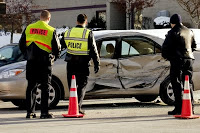Category Archive: Parents

Five Tips Before Teens Get Their Drivers License
October 6, 2010
A common rite of passage for teenagers is getting their driver’s license. Before teens get their license, they have to prepare themselves thoroughly. Here are a five tips for teens as they work towards their driver’s license:
1. Study the handbook. It’s surprising what kind of motivation teens have when it comes to studying for their driving test. The written part of the driving exam is pretty much like other tests for classes in school: you have to study to pass. You don’t study, you fail. You never know which part of the driving manual will appear in the exam, so it important to be well versed on the material to increase the chances of passing. If you decide you want to practice more, you can sign up for a drivers license practice test online course. You’ll get to see over 1,500 questions and answers similar to those found on the written driver’s test, along with detailed explanations.
2. Find out about the local GDL laws. Different states have different Graduated Drivers License (GDL) laws, and it’s worth noting that many states have varied age and time of day restrictions, passenger and mobile device limitations, and educational requirements before teens can get a full license. Also, the penalties and ordinances change depending on where you drive. Be familiar with the laws and ordinances for teen drivers for where you live and the places you plan to drive with your teen.
3. Make a covenant with parents. Straight talk and clear guidelines between teen drivers and their parents or guardians will assist teen driver safety. Setting boundaries that teens and parents can agree on will give teens an idea of the responsibility they will be undertaking. A Teen Driving Contract will help to guide and establish the expectations and consequences of driving privileges and behavior.
4. Practice makes perfect. A teen should always insist on getting more practice with their driving. On the other hand, parents and guardians over 21 years-old, should be more than willing to accompany them and teach them how to drive properly, especially in different types of weather and road conditions and environments, including nighttime, rain, and expressway driving. Several states require 50 hours of behind the wheel driving practice as a minimum, before full licensure. To help record this time, use a driving log. A printable version can be found at
5. No, focus makes perfect. Learning to maneuver the vehicle with ease and control is a milestone. But if a teen cannot stay focused, they are not ready to drive alone. This tip works in conjunction with the tips above. Giving each task the required amount of attention will make teen drivers reach their goal of becoming better drivers. Removing distractions to driving and keeping them focused on their interaction with the changing driving environment will not only make getting their license easier, it will help them be a safer driver.
Use these tips to help to set your teen up for success as they embark on preparing for their license. It is an exciting time of new endeavors and more independence. Have fun and be safe!

Distracted Driving Campaigns
July 9, 2010
Buzz, buzz…it will just take a second to check. Ring, ring…it could be important. Yeah, I should go ahead and make that call. It will save me the time and hassle later on. The temptation to reach out and/or respond to some one through a cell phone is great. You have heard the news stories and safe driving campaigns and you know that you shouldn’t, but…do you resist the urge to use the cell phone or let temptation get the best of you?
In order to completely eliminate the urge to use your phone you could turn it off before turning your key in the ignition, lock it up (in the glove box, console, or trunk), or install some of the new technology for cell phones. There are several companies offering services that will restrict the phone’s ability to send and receive text and email messages. Some companies offer services that will restrict calls too. A sampling include:
Textecution – http://www.textecution.com
Textecution is an application designed for parents to install on their children’s phones. It utilizes the GPS features of several handsets to determine if the owner of the phone is moving at more than 10mph. It disables the texting function of the phone. If the person with Textecution on their phone is riding a vehicle as a passenger, or in a bus or train need to use the text feature, there is an “override” option — requesting for text access from the administrator. The parent who installed the phone is designated as the administrator, and can allow, temporarily for the phone to allow texting features. www.safefloridadriver.com
iZUP – http://www.getizup.com/
iZUP disables your phone entirely, removing any distraction from the road. It automatically forwards calls to voicemail and holds text messages while the phone is in motion. It is also time-delayed, to prevent reactivation of the phone’s features in natural stopping areas, like stop lights. The phone will only allow the user to make calls to 911 and 3 pre-approved numbers.
TXTBlocker – http://www.txtblocker.com/
TXTBlocker utilizes GPS locations to detect if the phone is traveling at a car’s moving rate and disables features of the phone accordingly. The installer of the TXTBlocker phone can also designate which areas are no-phone zones, and deactivates texting, calling, email and browsing. There’s also a feature that auto sends a text message to the parent, should the phone be moving at speeds greater than 65mph. Another safety feature for parents is they could check where the owner of the phone is in, based on GPS location. The phone will still be able to dial 911, in case of emergency. It only checks in with GPS every few minutes, so it doesn’t constantly use the phone’s battery.
DriveSafe.ly – http://www.drivesafe.ly/
DriveSafe.ly is a hands-free application that reads out text messages and emails as the phone receives it. There is an optional auto-responder that sends out a customized text message while the application is active.
Committing to be distraction free when you are driving is not easy. But the statistics remind us each day that we are more likely to have a collision when we are distracted, many drivers are making an effort. Regardless of whether it is hand held or hands free, the cell phone is a distraction for every driver.
Learn more about the Measures Taken to Stop Distracted Driving.

GPS Tracking Technology that Promotes Safe Teen Driving
July 6, 2010
GPS technology has existed for at least 30 years and over the last decade, we’ve seen a boom in consumer devices that utilize it. With faster satellite relays and increased accuracy it’s no wonder that there are more practical applications for everyday GPS use; for instance, teen driving safety
Most people think of in–vehicle GPS systems as simply a tool for helping a driver to get directions from point A to B however there are several GPS systems that are being marketed to parents for safer teen driving. All of these systems help parents or guardians keep track of the whereabouts of their teen driver via GPS location and only differ in the features they’ve included with each one.
Here’s a quick rundown on some of them:
Spark Nano – http://www.brickhousesecurity.com/product/spark+nano+gps+tracking+device.do, $99 plus subscription fees
The Spark Nano is marketed as the smallest, most highly-sensitive GPS tracking device for tracking teen drivers. This battery operated, web enabled device allow parents or guardians to keep track of their teen in real time. It also keeps track of speed, so parents know how fast their teen driver was going. The additional feature in this one is a panic button, which when pressed sends out alerts to parents of their location and that they are in need of assistance.
mobileteen GPS – http://www.mobileteengps.com/, $299 plus monitoring plan
The mobileteen GPS system, when installed in a vehicle, allows a parent/guardian to keep track of how fast the car was moving, and how long the car has been in one location. Parents/guardians can login to their site to monitor real-time activities. It also allows parents/guardians to set a “ForceField” to alert them via text messaging or email when the car moves, useful when they are out of town, or when the teen is forbidden from driving. It also allows them to set approved/unapproved driving locations and to be alerted when a violation is committed. There is also a Repair/Response feature that helps locate teen drivers when they are having problems with the vehicle.
Safe Teen Driving Club’s Active GPS System – https://www.safeteendrivingclub.org/prodpurchase_vt.php.
This system also acts as an anti-theft device for the vehicle and could help lower insurance rates. The Active GPS System only activates when the ignition is on. It tracks speed and location, and sends out automatic reports (set by the user). The parent or guardian may also check a web-based site to view the real-time coordinates of their teen driver on a map. This system has to be professionally-installed, and that may add to the total cost of the system.
Marcus Teen Tracking System –
The Marcus Teen Tracking System provides real-time location information on your teen drivers and alerts parents or guardians if they go beyond a certain speed. It also allows the creation of unapproved driving zones and provides driving directions.
Additional Driver Safety Information on In-Vehicle Technology:
The Drawbacks Of In-Vehicle Technology

Teen Driver Safety – When the Crash Isn’t Avoided
June 23, 2010
More often than not, teenagers are taught how to avoid vehicle crashes as opposed to correct procedures if they are ever a crash. Obviously, new drivers are taught defensive driving techniques to ensure their safety on the roadways and to minimize their risks. However, odds are that most teenagers will be involved in at least a minor crash.
The period of time between Memorial Day Weekend and Labor Day is when the most teenagers are involved in vehicular crashes. Below, you will find a basic checklist of things you should go over with your teenager to provide a better understanding of what to do after as well as the insurance aftermath from the crash.
- Discuss insurance basics: If you haven’t already explained to your teenager how insurance rates and premiums work, this is probably a good place to start. Explain why it costs much more to insure an experienced driver and explain the savings associated with a good driving record.
- Consider a contract: A teen driving contract would outline what is expected of the teenager (i.e. safe driving practices, curfews, etc). It would also outline who would cover the rise in insurance costs following a crash and any other consequences your teenager would face as a result of failing to live up the expectations you outlined.
- Insurance and Registration should be in the glove box: Make sure your teenager knows to have the insurance card and registration in a place that is easily accessible and won’t get lost. The glove box is the ideal place.
- Some additional things to consider keeping on hand: A small first-aid kit, self-lighting emergency flares, a disposable camera, a small notebook and a pen to take down another driver’s contact information, and lastly, names/numbers for rescue personnel to contact.
- Document the Crash: Photograph the incident, even if there is minimal damage. If you don’t have a disposable camera in your car the camera on your phone will suffice. If there were any witnesses make sure to get their names and numbers. Witnesses can help you sort out details later.
- File a police report: it is best to file a police report and have it recorded. This is the choice of both drivers to determine even if it was just a fender bender.
- Don’t place blame: Getting involved in a game of finger pointing with another driver is never a good idea. Instruct your teenager to wait in the vehicle until the police arrive if the other driver is trying to confrontational. No good can come from getting in a fight with the other driver.
Even if you think you were at fault, you may not be. That’s why insurance agents recommend that you not accept fault or blame at the scene. It is best to let the police officer sort it out.

Graduated Drivers License Laws Around the United States
June 3, 2010
Young drivers in the United Stares are subject to many different laws, regulations and procedures. Many of the rules, regulations, privileges and limitations are similar from state to state but some also differ greatly. It would be overwhelming to compare the rules and regulations young drivers face in all 50 states. It’s easier to compare the policies of a handful of states. Many states differ on age young drivers can obtain their learner’s permits and driver’s licenses; they also differ on nighttime driving and passenger restrictions. Additionally the amount of supervised driving various from state to state and the length of time a young driver needs to have a learner’s permit before they can obtain a driver’s license various as well.
Minimum Age to Obtain a Leaner’s Permit
Many states allow teenagers to get their learner’s permits once they have turned 15. The minimum age to obtain a learner’s permit in Florida, Georgia and Texas is 15. In Colorado and Illinois 15 year olds can obtain their learner’s permits if they are enrolled in drives education. In California, teenagers must be 15 years and 6 months old before they can obtain their learner’s permits. Teenagers in New York are ineligible to obtain their permits until they turn 16.
Requirements to obtain a Driver’s License
After obtaining their learner’s permits young drivers are required to possess their permits for a specific amount of time until they are able to take their road tests (assuming they have reached the minimum age to take the toad test). In California, Texas and New York young drivers are only required to have a permit for six months before they take the road test for their driver’s licenses (or restricted licenses). In Illinois a permit is required for nine months before the road test can be taken. Colorado, Florida and Georgia require young drivers to keep their permits of a minimum of 12 months.
Before young drivers are able to get their licenses they are required to log a specific be amount of time behind the wheel. Most states require that 50 hours of driving time be completed and that 10 or 15 of those hours include nighttime driving. However, Texas only requires that 20 hours of driving being completed. But, at least 10 out of the 20 hours needs to be nighttime driving. Georgia requires that drivers complete at least 40 hours of driving and that at least 6 of the hours are night time driving.
In order to obtain a driver’s license or restricted license most states require that driver’s be at least 16 and have taken driver’s education. In order to get a driver’s license without taking a driver’s education course most states require the drivers to be 17 or 18. New York State issues a junior license to 16 year olds who have held their permits for at least 6 months. If they take driver’s ed they are eligible for their senior licenses at 17, if not, they must wait until their 18. For 16 year olds in Florida, they can take the road test for their license when they turn 16 regardless if they have taken driver’s education.
Driver’s License Restrictions
Most states do not give newly licensed 16 year old boys and girl complete freedom behind the wheel. Most states have nighttime driving restrictions and many states have restrictions on the number of passengers young drivers can have in their vehicles. For example, 16 year old drivers in Florida are not permitted to drive between 11pm – 6 am and 17 year old drivers in Florida are not permitted to drive between 1 am – 5 am. Drivers in New York adhere to restrictions from 9 pm – 5 am. And drivers in Colorado and Texas adhere to nighttime driving restrictions from 12 am – 5 am.
Out of the seven states compared here, Florida is the only one that does not have a restriction in place for the number of passengers young drivers are allowed to have in their vehicles. In California, for the first 12 months young drivers are not allowed to have any non-immediate family passengers under the age of 20 in their vehicles. In Colorado and Georgia, drivers are restricted to zero passengers for the first six months they have their license and no more than one for the second six months. In Texas, Illinois and New York young drivers are not allowed to have more than one passenger under the age of 21 in the vehicle. Again, immediate family members are an exception to the rule.
